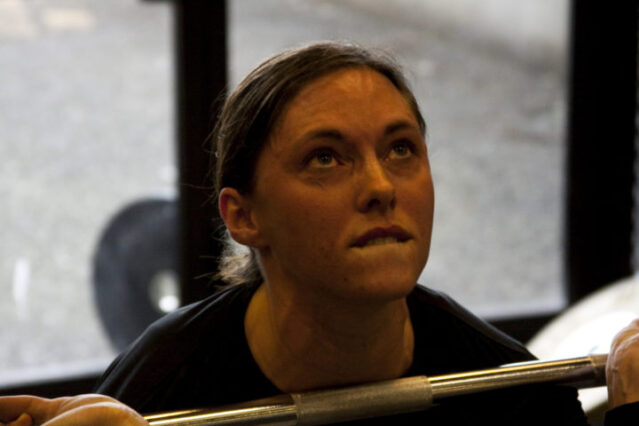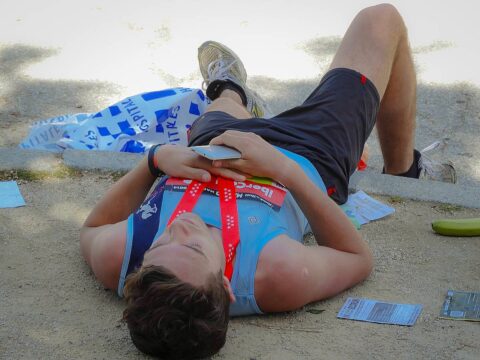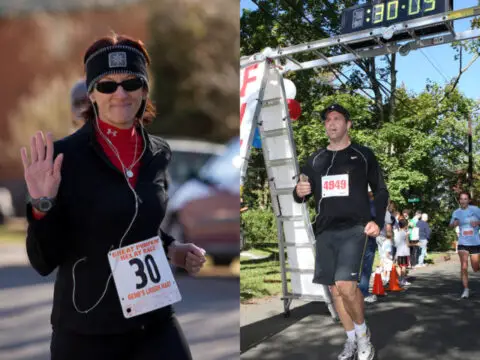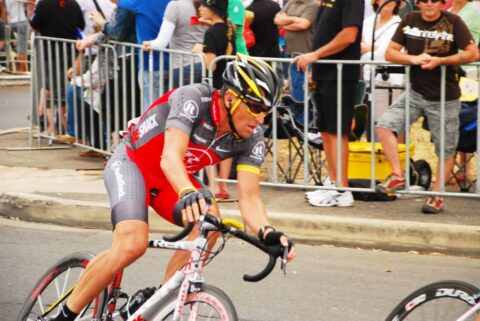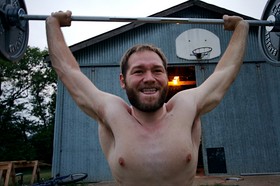 “They” say real men (and women) do free-weight squats.
“They” say real men (and women) do free-weight squats.
“They” say those leg machines are for wimps.
In the weightlifting world, free-weight squats separate the men from the boys and the women from the girls. There’s a certain squat snobbery you find among serious weight lifters.
Putting all that aside, there may be good reason for you to be doing free-weight squats as a triathlete.
First off, hopefully you know the importance of strength training for a triathlete. We’ve discussed strength training for triathletes here before.
This post is specifically about evaluating free-weight squats for the triathlete…
As a quick overview, there are 4 main arenas of weightlifting:
- Powerlifting – Powerlifting is a strength sport, consisting of 3 events: the squat, the bench press, and the deadlift.
- Weight Lifting – Weightlifting, also called Olympic weightlifting or Olympic-style weightlifting, is a sport in which participants attempt a maximum weight single lift of a barbell loaded with weight plates. The 2 lifts currently competed are the clean and jerk and the snatch.
- Body Building – Bodybuilding is a competition of muscular physique.
- Strength Training – Strength training encompasses areas such as general fitness, and functional muscular strength or endurance for specific sports.
The Squat
Most weightlifters attest to the fact that the free-weight squat is one of the most demanding lifts.
The squat is primarily a lower body exercise, which targets the quadriceps and the glutes, but it also involves the hamstrings, the calves, abs, and the lower back. The squat is quite possibly the best overall strength-building exercise.
During a proper squat, even the lats and pecs (chest) get stimulated as stabilizer muscles. The squat is often called “the king of exercises” by those who believe it is capable of inducing more and faster muscle growth than any other exercise.
The basic squat is performed by bending the legs at the knees and hips, lowering the torso between the legs, and then reversing direction to stand up straight again. The torso leans forward to maintain balance.
Proper technique is critical, otherwise very serious injuries or gradual injury over a period of time can occur. The back must maintain its natural curvature and not “round out,” otherwise excess strain can be placed on the spine and cause serious injury. Lifting belts are often used to help support the lower back while doing the lift.
Free-Weight Squats
There are several different versions of free-weight squats.
A few of the most popular include:
- Back Barbell Squat
- Front Barbell Squat
- Dumbbell Squat
- Step-Up Squat (barbell or dumbbell)
- Split Squat
Squats are also often classified by how far you go down with the barbell:
- The quarter squat descends about half of the way down towards a half squat.
- The hams parallel squat descends until the bottom of the thighs, the hamstrings, reach an imaginary line drawn parallel to the floor.
- The quads parallel or powerlifting legal squat descends until the crease of the top of the thighs at the hips is lower than the tops of the knees.
- The half or thighs parallel squat descends to a depth that is between hams-parallel and quads-parallel. The whole leg is parallel to the ground.
- The full or ass to the grass/ground (ATG) squat descends past quads-parallel to the maximum that a lifter’s flexibility allows. This is the common depth for Olympic weightlifters, as receiving the weight from a clean and jerk, usually ends up at the deepest point.
Squatting below parallel qualifies a squat as deep, while squatting above it qualifies as shallow.
Why Some Say Not To Do Free-Weight Squats
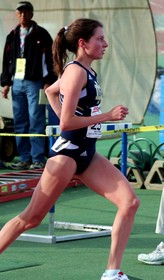 It is likely that if you asked 10 people about squats, 7 of them will discourage you from doing them. They will likely say that squats are bad for the knees and lower back.
It is likely that if you asked 10 people about squats, 7 of them will discourage you from doing them. They will likely say that squats are bad for the knees and lower back.
In fact, if you asked 10 doctors (like your family physician or internist), they would probably say the same thing.
The doomsday squat opinion, however, should be met with some skepticism. The truth is that the main reason why people are negative about free-weight squats is because they have heard a story about how someone was injured doing them.
The next thing you should know is the reason why most people get injured doing squats is because they don’t do them properly. Therefore, many medical professionals, when asked about free-weight squats, will likely warn against them because they know that the rank-and-file amateur fitness enthusiast is going to do them wrong and hurt themselves.
Reasons To Do Squats In General
Contrary to popular belief, squats are actually very good for your lower back.
A personal trainer friend of mine explained that when performed properly, squats do not stress the back or knees at all. Rather, they strengthen both areas indirectly — increasing blood flow to the areas and actually promoting the regeneration of healthy muscle regeneration.
Reasons To Do Free-Weight Squats
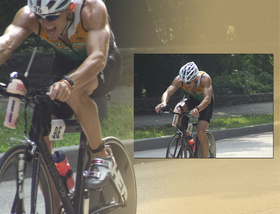 So, what would be the reasons for doing free-weight squats for a triathlete?
So, what would be the reasons for doing free-weight squats for a triathlete?
First and foremost, the free-weight squat is an excellent strength building exercise pertaining to the muscles most utilized for cycling and running.
It is an excellent exercise for building core strength and lower body strength, and contributes to upper-body strength and cardio conditioning.
The free-weight squat meets the requirements that Joe Friel lays out in The Triathlete’s Training Bible for the best strength training exercises for triathletes:
- Free-weight squats focus on “prime movers” or the big muscle groups
- Free-weight squats help prevent muscle balances by being a total body exercise
- Free-weight squats are a multi-joint exercise
- Free-weight squats improve core muscle strength
Free-Weights vs Machines
The primary difference between doing free-weight exercises and machines is that free-weight exercises utilize much more muscle fiber than machines do. Free-weights are also better for working on your stabilizer muscles in order to keep control of the weights, something you do not have to do with machines.
When you are using a machine the focus is on an isolated muscle, so you are not working many muscle fibers at all. When you are lifting with free weights you are using many more muscle fibers and stabilizer muscles. Plus, you are getting a much greater range of motion, which makes free-weight exercises superior to their machine equivalents.
For example, if you were to do squats on a machine — such as the leg press — you are only working on your legs. If you were to do squats free-weight style, you are not only working on your legs but are also working on your lower back because it is needed to stabilize the weight. When any stabilizer muscle is used, you are not only getting a stronger base but you are also making your muscles grow faster.
Some people feel that machine exercises have an advantage for the beginner and, in some cases, for an injured athlete. Unlike free weights, machines use a strict range of motion — only working on one specific muscle per exercise, which helps to reduce injuries while lifting. If you are an injured person, machines may be helpful because they isolate the muscle you injured and help it to gain back strength and flexibility.
Incorporating free-weight squats into the strength training component of your overall triathlon training plan has a lot of benefits. However, we shouldn’t be careless or turn a blind eye to the danger of free-weight squats if not done properly. Bad form and using too much weight are the 2 most common causes of squat injuries. If you feel there is a medical reason or prior back injury that might make free-weight squats unwise, talk with someone who is a professional in sports medicine.
I’m over 40 years old, but I don’t give up easily. It wasn’t too long ago that I was exploring the idea of doing my first triathlon. If I can do it, you can too! I'm proof that with a little determination and training, you can get a great deal of fulfillment participating in marathons, triathlons… even ultramarathons.
